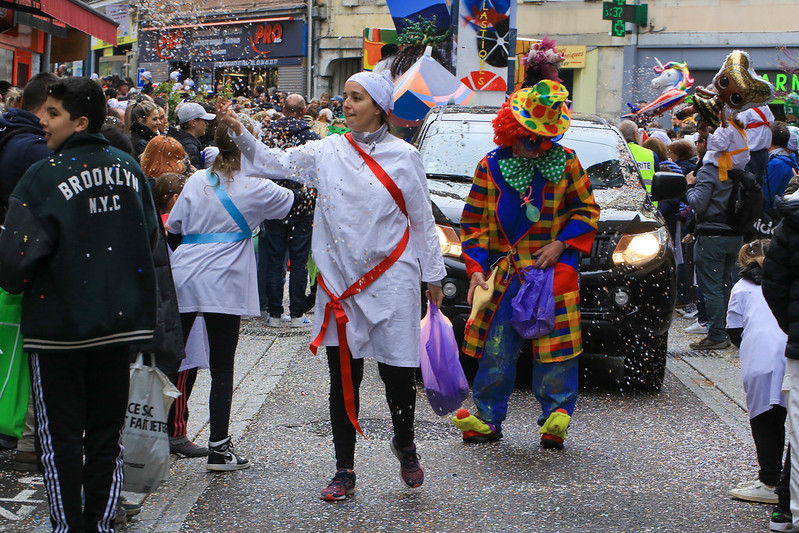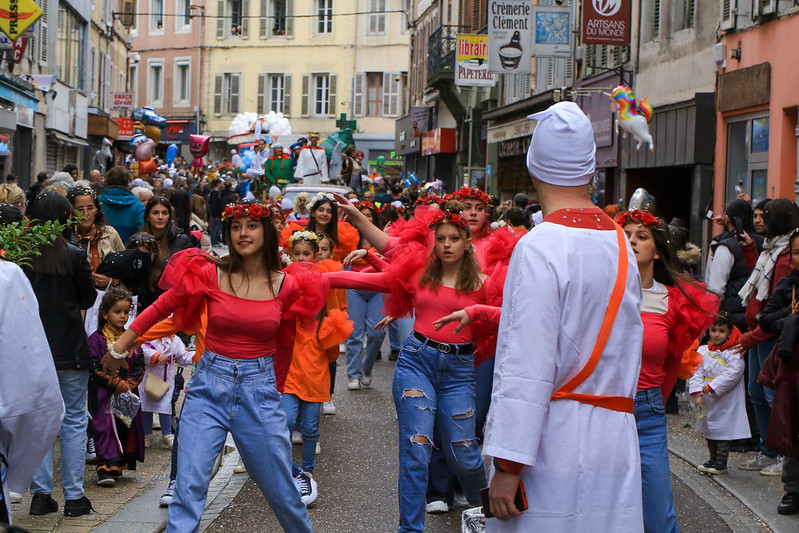Soufflaculs de Nontron
Dordogne’s Spring Festival of White Nightgowns, Whistles, and Laughter
2026/04/10 - 2026/04/12
With the arrival of spring, the small town of Nontron in France’s Dordogne region bursts into life with the Soufflaculs festival. Over a lively weekend, locals dress in white nightgowns and cotton bonnets, parading through the streets with bellows and whistles in hand. This boisterous parade is a tradition full of humor, meant to drive away evil spirits and poke fun at the powerful. Locals, returning residents, and travelers alike join in, filling the town with laughter, satire, and a strong sense of community.
The festival is held every year on the weekend after Easter, welcoming families, pranksters, and anyone who loves a good laugh. Recognized as part of France’s Intangible Cultural Heritage, it’s a unique spring festival where you can experience living folklore dating back to the Middle Ages.
Main Attractions
Whistling Parade & Flour Battles
The heart of the festival is the parade. Hundreds of Soufflaculs, dressed in long white nightgowns, nightcaps, and wooden clogs, walk through the old town with faces dusted in flour and bellows in hand. The comical act of blowing air with the bellows at the person in front’s bottom fills the town with laughter and the sound of whistles. Flour flies, people jostle, and Occitan songs fill the air, creating a carnival atmosphere that’s both wild and warm.
Key Events
Saturday night opens with a grand banquet and live music, as well as the election of “Miss Soufflette.” On Sunday, after the parade, the symbolic “Buffadou” effigy—representing winter and mischief—is put on “trial” and burned. Street performances, games, and the “Valiant Sardine Award” keep the laughter going until sunset.
Costumes and Decorations
The classic look is a white nightgown, cotton bonnet, and red wooden clogs. Women are required by city ordinance to wear skirts, while faces are hidden with fake noses, masks, or flour. Some groups link their nightgowns together to form a “caterpillar.” The town is decorated with banners, garlands, and Soufflaculs statues, creating a humorous and festive atmosphere.
Cultural and Historical Background
The origins of the Soufflaculs date back to the Middle Ages, when townspeople would mock the powerful and clergy by dressing up, turning social order upside down before Lent. The bellows and flour were believed to drive away evil spirits, especially those hiding under women’s skirts. Despite wars, bans, and near extinction, the festival was revived by local volunteers in 1979. Today, it is a symbol of Nontron’s pride and sense of humor, and in 2010 it was officially recognized as part of France’s Intangible Cultural Heritage.
Participant Voices
I brought my children for the first time. They loved the costumes and the chaos, and in the end, the whole family was covered in flour and laughing out loud. We hadn’t enjoyed ourselves together like this in ages. I didn’t get all the jokes, but the welcoming spirit was real—Nontron really knows how to throw a festival!
Fun Facts
- “Soufflaculs” literally means “bottom blower”—a name that reflects the festival’s cheeky humor.
- Women are required by city ordinance to wear skirts, while men must wear nightgowns and bonnets.
- The burning of the Buffadou effigy symbolizes the end of winter and mischief.
- The town features Soufflaculs statues and even a “Rue des Soufflets” (“Bellows Street”) to keep the tradition alive.
Festival Dates
Soufflaculs de Nontron is held every April in Nontron.
The event schedule is subject to change. Please check the official website for the most up-to-date information.
Information
| Name | Soufflaculs de Nontron |
| Country | France |
| Area | Nontron |
| Date | 2026/04/10 - 2026/04/12 |
| Link |
Upcoming Festivals
Whirling Dervishes Festival Turkey
A Mesmerizing Dance of Divine Love
2025/12/06Mevlana Celaleddin Rumi Commemoration Ceremony ( Şeb-i Arus ) Turkey
A Whirling Journey to Divine Love
2025/12/10Dia de la Virgen de Guadalupe Mexico
A Festival Weaving Faith, Fervor, and Mexican Identity
2025/12/11L'Escalade Switzerland
Geneva’s Grand Winter Festival of Courage, Chocolate, and Community
2025/12/12Umkhosi Wokweshwama South Africa
The Zulu First Fruits Festival—A Sacred Celebration of Land, Ancestors, and Renewal
2025/12/12Lucia Festival (St. Lucia's Day) Sweden
A Festival of Light Illuminating the Nordic Darkness
2025/12/15Las Posadas Mexico
The Luminous Quest for Sacred Shelter
2025/12/22Noche de Rabanos (Night of the Radishes) Mexico
A celebration blending art, farming heritage, and cultural traditions
2025/12/23Chant of the Sybil on Majorca Spain
A Medieval Prophecy Echoes Through Majorcan Christmas
2025/12/23‘Hatajo de Negritos’ and the ‘Hatajo de Pallitas’ Peru
A Christmas Festival of Rhythm, Faith, and Afro-Andean Heritage in Peru’s Ica Region

